A Case Study of Agrarian Change: Agriculture and Development in Libya
VerifiedAdded on 2023/06/10
|10
|881
|441
Case Study
AI Summary
This case study critically analyzes the challenges and opportunities for sustainable development in Libya's agricultural sector, focusing on agrarian changes before and after the Gaddafi era. It evaluates the prevailing economic policies, reviews the impact of pre- and post-Gaddafi policies on agriculture, and assesses how problems in the agricultural sector affect the potential for modernization and a shift to a sustainable agricultural system. The analysis considers factors such as Libya's desert climate, limited water resources, and the impact of political instability on agricultural production and food security. The study references various books and journals to support its evaluation of Libya's economic structure and the potential for a more sustainable agricultural future, given the country's limited soil fertility and natural resources. Desklib provides this and other resources for students.

Paraphrase This Document
Need a fresh take? Get an instant paraphrase of this document with our AI Paraphraser
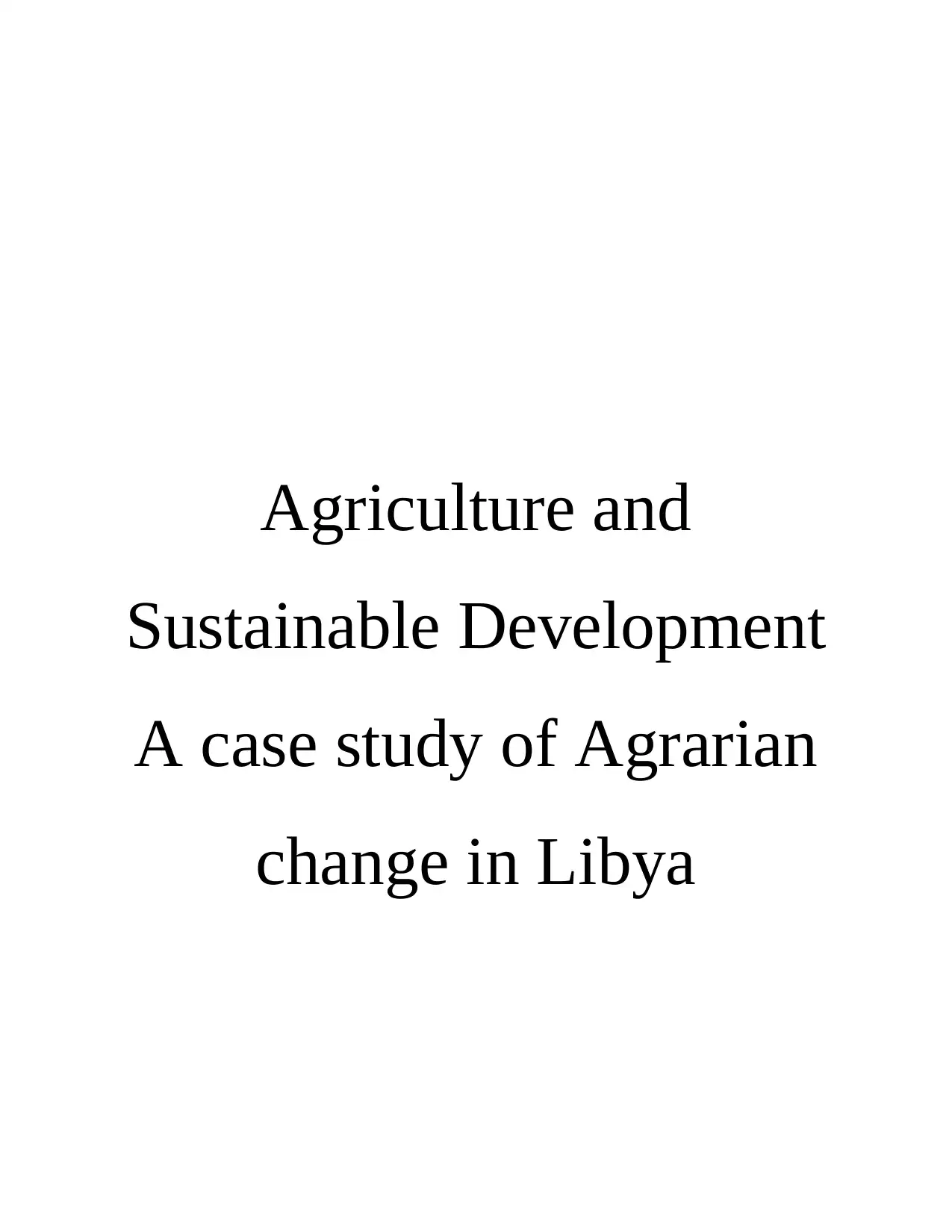
Agriculture and
Sustainable Development
A case study of Agrarian
change in Libya
Sustainable Development
A case study of Agrarian
change in Libya

Table of Contents
Critical Analysis...............................................................................................................................4
To recognize the prevailing economic policies and structure in Libya..................................4
To critically review and evaluate pre- and post-Gaddafi policies in the agricultural sector.. 4
To critically analyze and evaluate how the problems affecting the Libyan agricultural sector
impact the potential for other economic activities in the modernization of this sector..........4
To critically evaluate how problems affecting the Libyan agricultural sector impact the
mission of changing the economic structure to a sustainable agricultural system in a higher
context. ..................................................................................................................................5
References .......................................................................................................................................6
Libyan Agriculture: A Review of Past Efforts, Current Challenges and Future Prospects
Available at......................................................................................................................................6
Introduction......................................................................................................................................8
Main Body.......................................................................................................................................8
Conclusion.......................................................................................................................................8
References .......................................................................................................................................9
Critical Analysis...............................................................................................................................4
To recognize the prevailing economic policies and structure in Libya..................................4
To critically review and evaluate pre- and post-Gaddafi policies in the agricultural sector.. 4
To critically analyze and evaluate how the problems affecting the Libyan agricultural sector
impact the potential for other economic activities in the modernization of this sector..........4
To critically evaluate how problems affecting the Libyan agricultural sector impact the
mission of changing the economic structure to a sustainable agricultural system in a higher
context. ..................................................................................................................................5
References .......................................................................................................................................6
Libyan Agriculture: A Review of Past Efforts, Current Challenges and Future Prospects
Available at......................................................................................................................................6
Introduction......................................................................................................................................8
Main Body.......................................................................................................................................8
Conclusion.......................................................................................................................................8
References .......................................................................................................................................9
⊘ This is a preview!⊘
Do you want full access?
Subscribe today to unlock all pages.

Trusted by 1+ million students worldwide
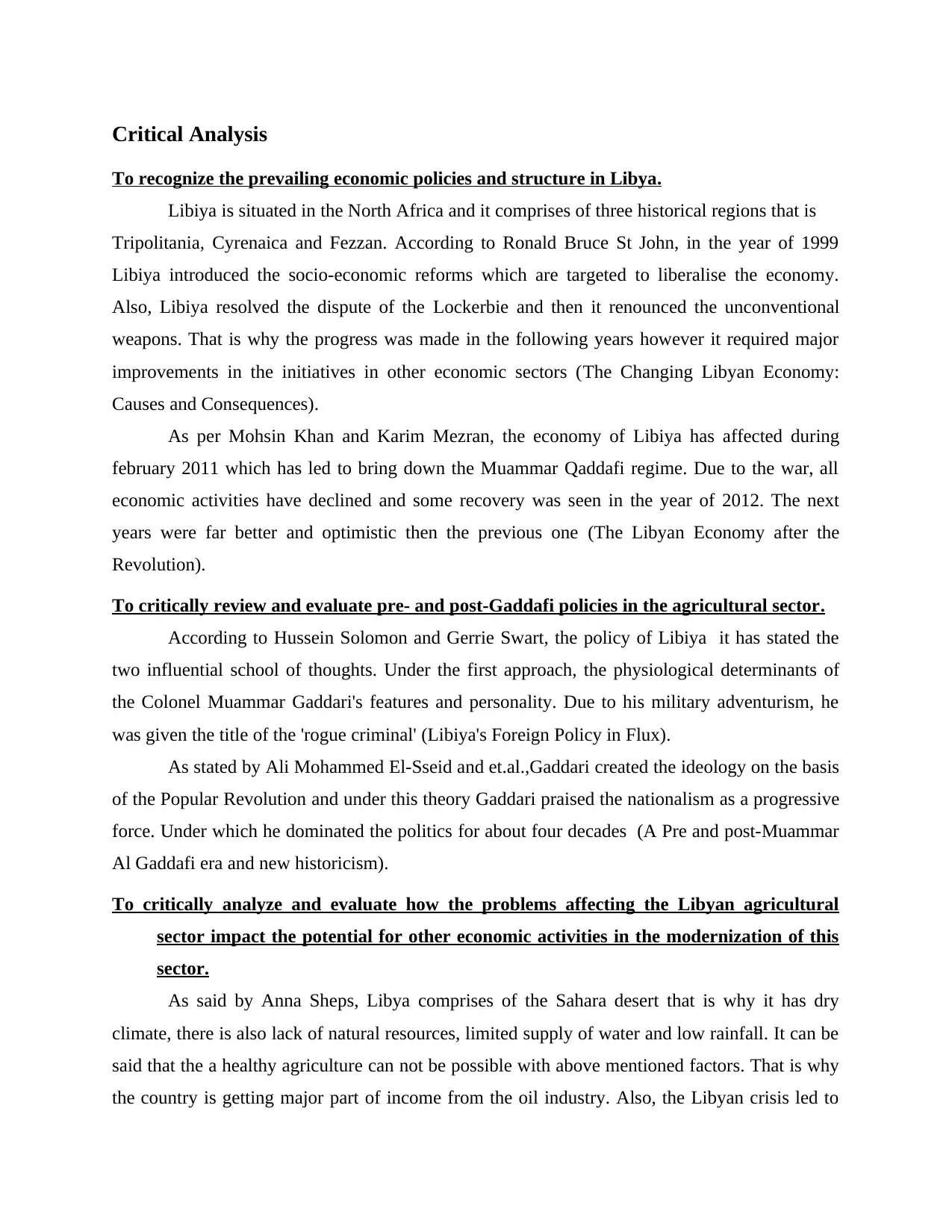
Critical Analysis
To recognize the prevailing economic policies and structure in Libya.
Libiya is situated in the North Africa and it comprises of three historical regions that is
Tripolitania, Cyrenaica and Fezzan. According to Ronald Bruce St John, in the year of 1999
Libiya introduced the socio-economic reforms which are targeted to liberalise the economy.
Also, Libiya resolved the dispute of the Lockerbie and then it renounced the unconventional
weapons. That is why the progress was made in the following years however it required major
improvements in the initiatives in other economic sectors (The Changing Libyan Economy:
Causes and Consequences).
As per Mohsin Khan and Karim Mezran, the economy of Libiya has affected during
february 2011 which has led to bring down the Muammar Qaddafi regime. Due to the war, all
economic activities have declined and some recovery was seen in the year of 2012. The next
years were far better and optimistic then the previous one (The Libyan Economy after the
Revolution).
To critically review and evaluate pre- and post-Gaddafi policies in the agricultural sector.
According to Hussein Solomon and Gerrie Swart, the policy of Libiya it has stated the
two influential school of thoughts. Under the first approach, the physiological determinants of
the Colonel Muammar Gaddari's features and personality. Due to his military adventurism, he
was given the title of the 'rogue criminal' (Libiya's Foreign Policy in Flux).
As stated by Ali Mohammed El-Sseid and et.al.,Gaddari created the ideology on the basis
of the Popular Revolution and under this theory Gaddari praised the nationalism as a progressive
force. Under which he dominated the politics for about four decades (A Pre and post-Muammar
Al Gaddafi era and new historicism).
To critically analyze and evaluate how the problems affecting the Libyan agricultural
sector impact the potential for other economic activities in the modernization of this
sector.
As said by Anna Sheps, Libya comprises of the Sahara desert that is why it has dry
climate, there is also lack of natural resources, limited supply of water and low rainfall. It can be
said that the a healthy agriculture can not be possible with above mentioned factors. That is why
the country is getting major part of income from the oil industry. Also, the Libyan crisis led to
To recognize the prevailing economic policies and structure in Libya.
Libiya is situated in the North Africa and it comprises of three historical regions that is
Tripolitania, Cyrenaica and Fezzan. According to Ronald Bruce St John, in the year of 1999
Libiya introduced the socio-economic reforms which are targeted to liberalise the economy.
Also, Libiya resolved the dispute of the Lockerbie and then it renounced the unconventional
weapons. That is why the progress was made in the following years however it required major
improvements in the initiatives in other economic sectors (The Changing Libyan Economy:
Causes and Consequences).
As per Mohsin Khan and Karim Mezran, the economy of Libiya has affected during
february 2011 which has led to bring down the Muammar Qaddafi regime. Due to the war, all
economic activities have declined and some recovery was seen in the year of 2012. The next
years were far better and optimistic then the previous one (The Libyan Economy after the
Revolution).
To critically review and evaluate pre- and post-Gaddafi policies in the agricultural sector.
According to Hussein Solomon and Gerrie Swart, the policy of Libiya it has stated the
two influential school of thoughts. Under the first approach, the physiological determinants of
the Colonel Muammar Gaddari's features and personality. Due to his military adventurism, he
was given the title of the 'rogue criminal' (Libiya's Foreign Policy in Flux).
As stated by Ali Mohammed El-Sseid and et.al.,Gaddari created the ideology on the basis
of the Popular Revolution and under this theory Gaddari praised the nationalism as a progressive
force. Under which he dominated the politics for about four decades (A Pre and post-Muammar
Al Gaddafi era and new historicism).
To critically analyze and evaluate how the problems affecting the Libyan agricultural
sector impact the potential for other economic activities in the modernization of this
sector.
As said by Anna Sheps, Libya comprises of the Sahara desert that is why it has dry
climate, there is also lack of natural resources, limited supply of water and low rainfall. It can be
said that the a healthy agriculture can not be possible with above mentioned factors. That is why
the country is getting major part of income from the oil industry. Also, the Libyan crisis led to
Paraphrase This Document
Need a fresh take? Get an instant paraphrase of this document with our AI Paraphraser
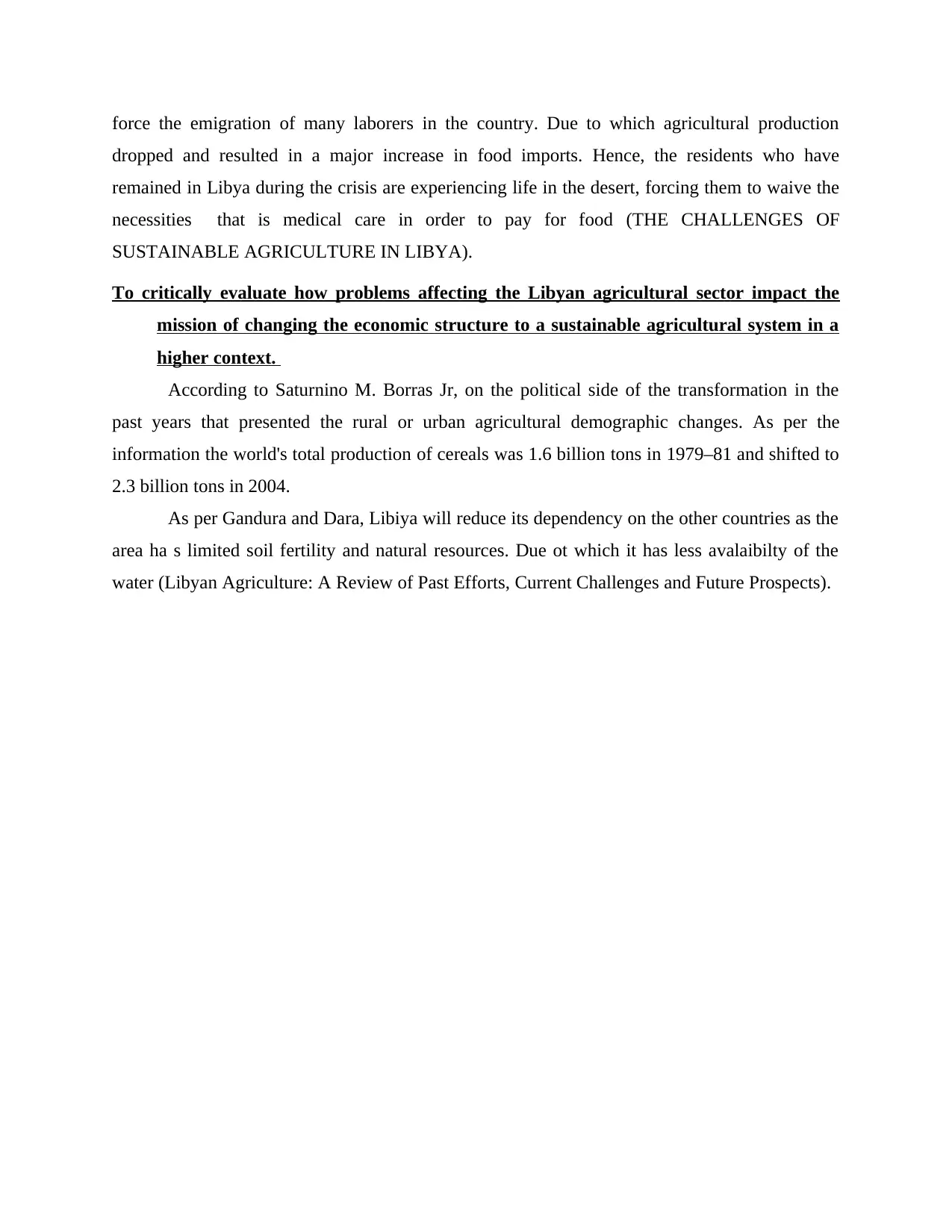
force the emigration of many laborers in the country. Due to which agricultural production
dropped and resulted in a major increase in food imports. Hence, the residents who have
remained in Libya during the crisis are experiencing life in the desert, forcing them to waive the
necessities that is medical care in order to pay for food (THE CHALLENGES OF
SUSTAINABLE AGRICULTURE IN LIBYA).
To critically evaluate how problems affecting the Libyan agricultural sector impact the
mission of changing the economic structure to a sustainable agricultural system in a
higher context.
According to Saturnino M. Borras Jr, on the political side of the transformation in the
past years that presented the rural or urban agricultural demographic changes. As per the
information the world's total production of cereals was 1.6 billion tons in 1979–81 and shifted to
2.3 billion tons in 2004.
As per Gandura and Dara, Libiya will reduce its dependency on the other countries as the
area ha s limited soil fertility and natural resources. Due ot which it has less avalaibilty of the
water (Libyan Agriculture: A Review of Past Efforts, Current Challenges and Future Prospects).
dropped and resulted in a major increase in food imports. Hence, the residents who have
remained in Libya during the crisis are experiencing life in the desert, forcing them to waive the
necessities that is medical care in order to pay for food (THE CHALLENGES OF
SUSTAINABLE AGRICULTURE IN LIBYA).
To critically evaluate how problems affecting the Libyan agricultural sector impact the
mission of changing the economic structure to a sustainable agricultural system in a
higher context.
According to Saturnino M. Borras Jr, on the political side of the transformation in the
past years that presented the rural or urban agricultural demographic changes. As per the
information the world's total production of cereals was 1.6 billion tons in 1979–81 and shifted to
2.3 billion tons in 2004.
As per Gandura and Dara, Libiya will reduce its dependency on the other countries as the
area ha s limited soil fertility and natural resources. Due ot which it has less avalaibilty of the
water (Libyan Agriculture: A Review of Past Efforts, Current Challenges and Future Prospects).
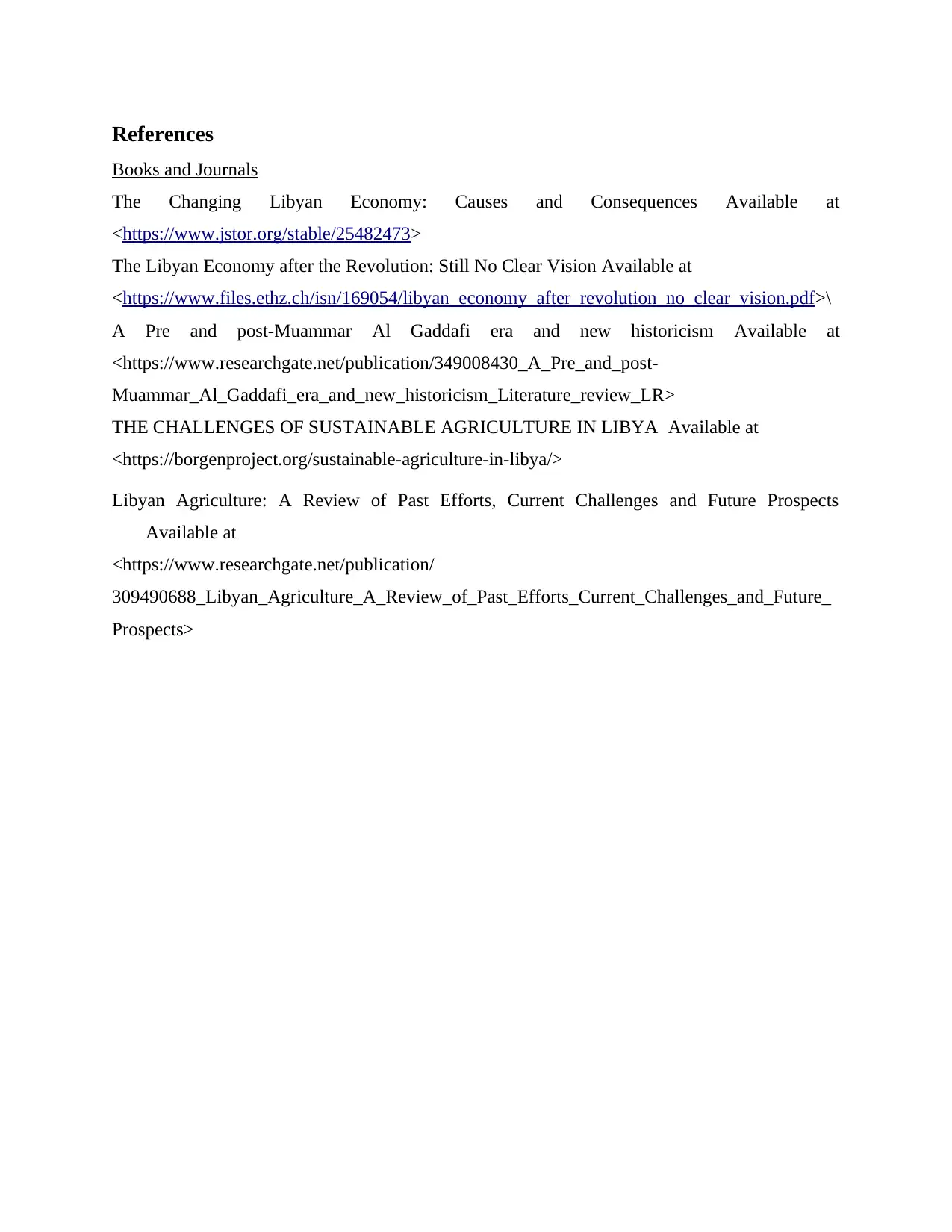
References
Books and Journals
The Changing Libyan Economy: Causes and Consequences Available at
<https://www.jstor.org/stable/25482473>
The Libyan Economy after the Revolution: Still No Clear Vision Available at
<https://www.files.ethz.ch/isn/169054/libyan_economy_after_revolution_no_clear_vision.pdf>\
A Pre and post-Muammar Al Gaddafi era and new historicism Available at
<https://www.researchgate.net/publication/349008430_A_Pre_and_post-
Muammar_Al_Gaddafi_era_and_new_historicism_Literature_review_LR>
THE CHALLENGES OF SUSTAINABLE AGRICULTURE IN LIBYA Available at
<https://borgenproject.org/sustainable-agriculture-in-libya/>
Libyan Agriculture: A Review of Past Efforts, Current Challenges and Future Prospects
Available at
<https://www.researchgate.net/publication/
309490688_Libyan_Agriculture_A_Review_of_Past_Efforts_Current_Challenges_and_Future_
Prospects>
Books and Journals
The Changing Libyan Economy: Causes and Consequences Available at
<https://www.jstor.org/stable/25482473>
The Libyan Economy after the Revolution: Still No Clear Vision Available at
<https://www.files.ethz.ch/isn/169054/libyan_economy_after_revolution_no_clear_vision.pdf>\
A Pre and post-Muammar Al Gaddafi era and new historicism Available at
<https://www.researchgate.net/publication/349008430_A_Pre_and_post-
Muammar_Al_Gaddafi_era_and_new_historicism_Literature_review_LR>
THE CHALLENGES OF SUSTAINABLE AGRICULTURE IN LIBYA Available at
<https://borgenproject.org/sustainable-agriculture-in-libya/>
Libyan Agriculture: A Review of Past Efforts, Current Challenges and Future Prospects
Available at
<https://www.researchgate.net/publication/
309490688_Libyan_Agriculture_A_Review_of_Past_Efforts_Current_Challenges_and_Future_
Prospects>
⊘ This is a preview!⊘
Do you want full access?
Subscribe today to unlock all pages.

Trusted by 1+ million students worldwide
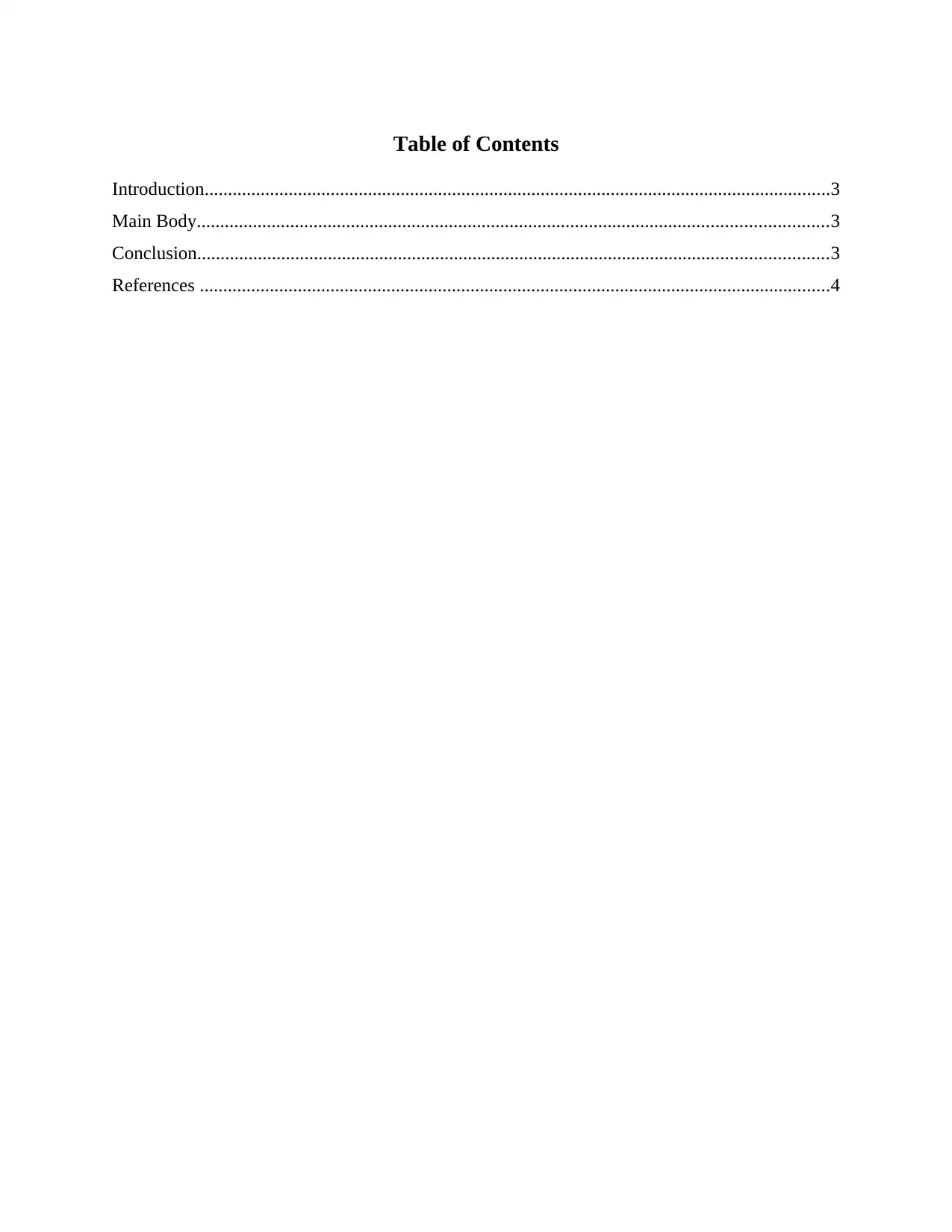
Table of Contents
Introduction......................................................................................................................................3
Main Body.......................................................................................................................................3
Conclusion.......................................................................................................................................3
References .......................................................................................................................................4
Introduction......................................................................................................................................3
Main Body.......................................................................................................................................3
Conclusion.......................................................................................................................................3
References .......................................................................................................................................4
Paraphrase This Document
Need a fresh take? Get an instant paraphrase of this document with our AI Paraphraser

Introduction
Main Body
Conclusion
Main Body
Conclusion
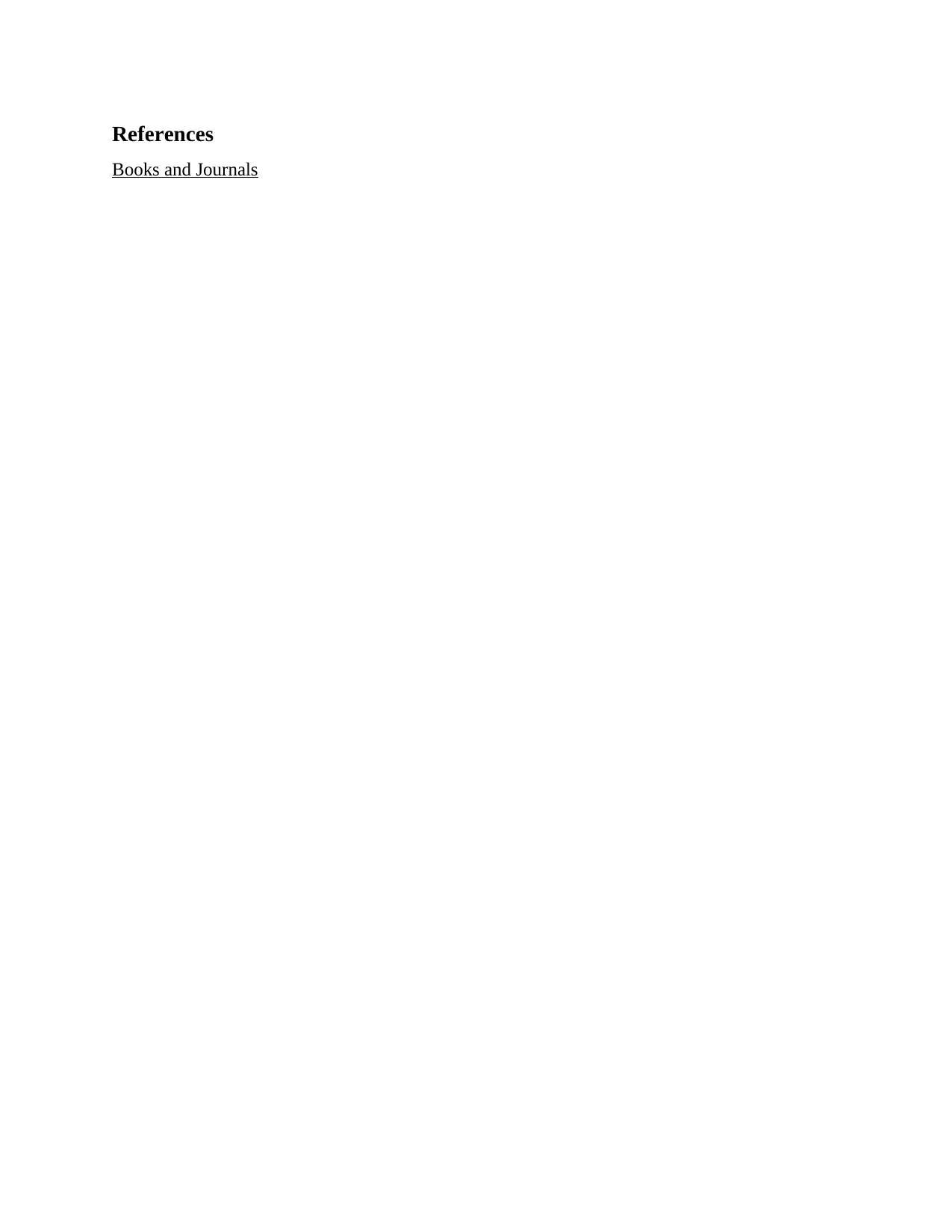
References
Books and Journals
Books and Journals
⊘ This is a preview!⊘
Do you want full access?
Subscribe today to unlock all pages.

Trusted by 1+ million students worldwide

1 out of 10
Related Documents
Your All-in-One AI-Powered Toolkit for Academic Success.
+13062052269
info@desklib.com
Available 24*7 on WhatsApp / Email
![[object Object]](/_next/static/media/star-bottom.7253800d.svg)
Unlock your academic potential
Copyright © 2020–2025 A2Z Services. All Rights Reserved. Developed and managed by ZUCOL.



